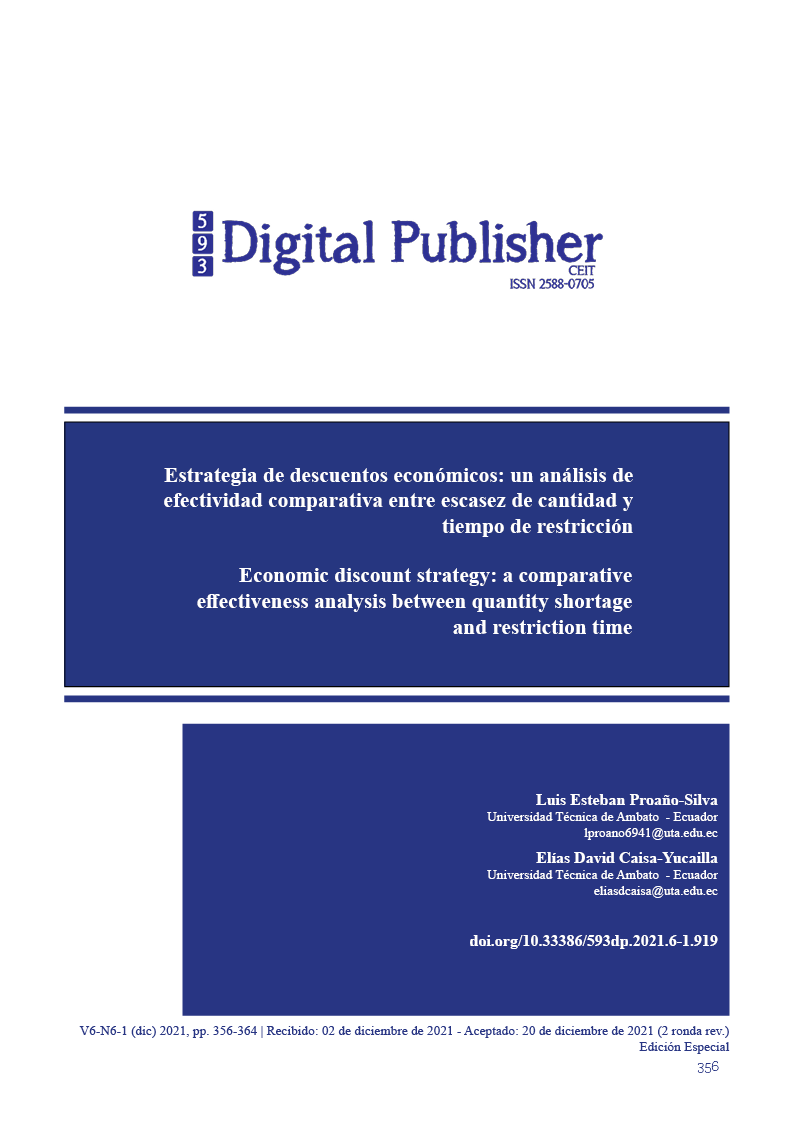Economic discount strategy: a comparative effectiveness analysis between quantity shortage and restriction time
Main Article Content
Abstract
The present work arises from the problem identified in retailers who sell the same product at different prices. Thus, it is critical that consumers assess the attractiveness of a specific sale price and that retailers facilitate that assessment. The objective of the work was to examine the perception of shortage of quantity in a monetary discount helps to improve the perceptions and intentions related to the supply of consumers. The method used was quantitative since the perception of consumers in the face of monetary discounts and restriction time was evaluated according to the correlational order. The study took into account 160 adult buyers from the commercial sector of the province of Tungurahua in Ecuador. The findings revealed that the relative effectiveness of quantity shortage and time restriction depends on the prominence of price-related signals in an ad. It is concluded that, the writing can help retailers to improve the effectiveness of monetary discounts to conditionally use the scarcity message and time restriction to increase the attractiveness of prices.
Downloads
Article Details

This work is licensed under a Creative Commons Attribution-NonCommercial-ShareAlike 4.0 International License.
1. Derechos de autor
Las obras que se publican en 593 Digital Publisher CEIT están sujetas a los siguientes términos:
1.1. 593 Digital Publisher CEIT, conserva los derechos patrimoniales (copyright) de las obras publicadas, favorece y permite la reutilización de las mismas bajo la licencia Licencia Creative Commons 4.0 de Reconocimiento-NoComercial-CompartirIgual 4.0, por lo cual se pueden copiar, usar, difundir, transmitir y exponer públicamente, siempre que:
1.1.a. Se cite la autoría y fuente original de su publicación (revista, editorial, URL).
1.1.b. No se usen para fines comerciales u onerosos.
1.1.c. Se mencione la existencia y especificaciones de esta licencia de uso.
References
Bodur, H.O., Klein, N.M. and Arora, N. (2015), “Online price search: impact of price comparison sites on offline price evaluations”, Journal of Retailing, Vol. 91No. 1, pp. 125-139.
de Aguilera-Moyano, J., Baños-González, M., and Ramírez-Perdiguero, J. (2015). Branded entertainment: Los contenidos de entretenimiento como herramienta de comunicación de marketing. Un estudio de su situación actual en España. Revista Latina de Comunicacion Social, 70(6), 519-538. https://doi.org/10.4185/RLCS-2015-1057
Gierl, H. and Huettl, V. (2010), “Are scarce products always more attractive? the interaction of different types of scarcity signals with products’ suitability for conspicuous consumption”, International Journal of Research in Marketing, Vol. 27No. 3, pp. 225-235.
Goldsmith, K. and Amir, O. (2010), “Can uncertainty improve promotions?”, Journal of Marketing Research, Vol. 47 No. 6, pp. 1070-1077.
Grewal, D., Roggeveen, A.L. and Lindsey-Mullikin, J. (2014), “The contingent effects of semantic price cues”, Journal of Retailing, Vol. 90 No. 2, pp. 198-205.
Gupta, S. and Cooper, L.G. (1992), “The discounting of discounts and promotion thresholds”, Journal of Consumer Research, Vol. 19No. 3, pp. 401-411.
Hayes, A.F. (2013), Introduction to Mediation, Moderation, and Conditional Process Analysis: A Regression-Based Approach, Guilford Press, New York, NY.
Herr, P.M. (1989), “Priming price: prior knowledge and context effects”, Journal of Consumer Research,Vol. 16No. 1, pp. 67-75.
Howard, D.J. and Kerin, R.A. (2006), “Broadening the scope of reference price advertising research: a field study of consumer shopping involvement”, Journal of Marketing, Vol. 70 No. 4, pp. 185-204.
Inman, J.J., Peter, A.C. and Raghubir, P. (1997), “Framing the deal: the role of restrictions in accentuating deal value”, Journal of Consumer Research, Vol. 24No. 1, pp. 68-79.
Janiszewski, C. and Lichtenstein, D.R. (1999), “A range theory account of price perception”, Journal of Consumer Research, Vol. 25No. 4, pp. 353-368.
Janiszewski, C. and Wyer, R.S. (2014), “Content and process priming: a review”, Journal of Consumer Psychology, Vol. 24 No. 1, pp. 96-118.
Kahneman, D. (2003), “Maps of bounded rationality: psychology for behavioral economics”, American Economic Review, Vol. 93No. 5, pp. 1449-1475.
Kirmani, A. and Rao, A.R. (2000), “No pain, no gain: a critical review of the literature on signaling unobservable product quality”, Journal ofMarketing, Vol. 64No. 2, pp. 66-79.
Kivetz, R. (2005), “Promotion reactance: the role of effortreward congruity”, Journal of Consumer Research, Vol. 31 No. 4, pp. 725-736.
Krishnan, B.C., Biswas, A. and Netemeyer, R.G. (2006), “Semantic cues in reference prices: the role of decision time pressure”, Journal of Retailing, Vol. 47No. 8, pp. 1314-1332.
Marketing, (2007). Los Costos del Marketing. Faces, 10, 104-117.
Real., and Mejía, J. E. (2013). La gestión del marketing que conecta con los sentidos / The market management which connects with the senses. Revista EAN, (73), 168-183.
Van Herpen, E., Pieters, R. and Zeelenberg, M. (2009), “When demand accelerates demand: trailing the bandwagon”, Journal of Consumer Psychology, Vol. 19 No. 3, pp. 302-312.



